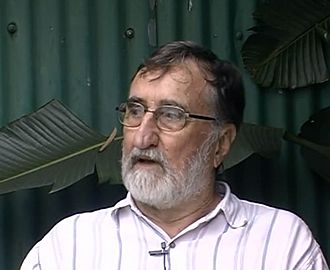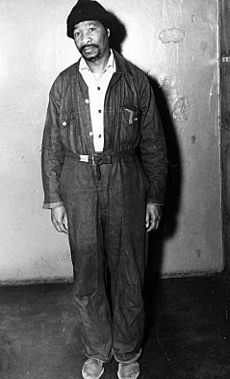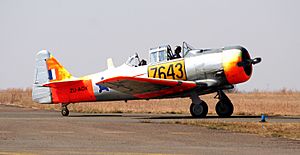Harold Strachan facts for kids
Quick facts for kids
Harold Strachan
|
|
|---|---|

A still from an interview with Strachan in 2010
|
|
| MK Chief of Explosives | |
| In office 1961–1963 |
|
| Preceded by | office established |
| Succeeded by | vacant |
| Personal details | |
| Born |
Robert Harold Lundie Strachan
1 December 1925 Pretoria, South Africa |
| Died | 7 February 2020 (aged 94) |
| Spouses |
|
| Occupation |
|
| Military career | |
| Allegiance | South Africa |
| Service/ |
|
| Years of service | 1943-1946 |
| Rank | Lieutenant (SAAF) |
Robert Harold Lundie "Jock" Strachan (born December 1, 1925 – died February 7, 2020) was a white South African writer and activist. He worked to end apartheid, a system of unfair rules against black people in South Africa. Harold flew planes for the South African Air Force during World War II. He also trained as an artist. Later, he became the first expert in explosives for Umkhonto we Sizwe (MK), a group fighting apartheid.
He was put in prison for his actions against the government. After his release, he was jailed again for telling a journalist about the tough conditions in prison. Harold wrote two books about his life. He also ran the difficult Comrades Marathon race twice, winning a medal once. He was married two times and had three children.
Contents
Early Life, Art, and Running Achievements
Harold Strachan was born in Pretoria, South Africa, on December 1, 1925. His father was a metalworker from Scotland. His mother was a teacher from an Afrikaner family. When Harold was three, his mother moved with him and his two sisters to Pietermaritzburg. He went to Merchiston Preparatory School and then Maritzburg College. Here, he started to think more about politics and fairness.
After school, Strachan joined the South African Air Force. He served as a pilot near the end of World War II. He trained on planes like the de Havilland Tiger Moth and the Airspeed Oxford. From 1946 to 1949, he studied Fine Arts at Natal University College. In 1948, the ruling National Party started apartheid. This was a system of separating people by race and treating black people unfairly.
In 1949, Strachan completed the Comrades Marathon. This is a very long race, about 89-kilometre (55 mi) (55 miles), between Pietermaritzburg and Durban. After leaving the air force, he continued to fly planes as a reservist. This helped him stay skilled as a pilot.
In 1950, Strachan won a scholarship to study art in London. He married Jean Middleton, who was also from South Africa. In 1951, he took a course in painting restoration in Germany. He returned to London in 1952 and worked as a security guard. In 1953, he helped manage a painting business in Chingola, which is now in Zambia. There, he encouraged the black workers to form a union. During the 1950s, he worked with artist Selby Mvusi.
Before the 1954 Comrades Marathon, Strachan prepared for the race in an unusual way. He finished sixth in 7 hours and 48 minutes, earning a gold medal. He worked as a lecturer and teacher from 1955 to 1960. He and Jean Middleton divorced in 1958.
Fighting Apartheid and Imprisonment
Harold Strachan opposed apartheid because he believed it was wrong. He became a founder of the Liberal Party of South Africa in 1954. In 1957, he joined the South African Congress of Democrats. In 1959, he married Maggie von Lier, who had been his student. In 1960, during protests after the Sharpeville massacre, Harold and Maggie bravely stood between armed police and black protesters. This stopped the police from shooting.
A warrant was issued for their arrest, so they went to Swaziland to be safe. Three months later, they returned to South Africa. Harold used a different name, Robert "Jock" Lundie. They settled in Port Elizabeth. There, Harold worked with Govan Mbeki to create and share a newsletter called Izwe Lomzi ("Voice of the People"). In 1961, he joined the illegal South African Communist Party. He also edited their newspaper, New Age.
Harold agreed to Mbeki's request to create simple explosive devices for the new group, Umkhonto we Sizwe (MK). He experimented with different substances to make them.

Strachan was MK's first expert in explosives. He designed a simple fire-starting device using petrol. He later created a stronger explosive. He trained other people, who then shared this knowledge secretly. His homemade devices were placed at important places like power stations and railway lines. As far as we know, no one died in these attacks.
He was caught when one of his trainees planted a device that did not work properly. It was found, and the operative was traced by fingerprints. Under pressure from the police, the operative revealed Strachan's address. Strachan was arrested and tried. He was found guilty of sabotage on May 8, 1962. He was sentenced to six years in prison, but three years were suspended. He spent thirteen months of his sentence alone in Pretoria Central Prison. To pass the time, he imagined building a model airplane and practicing flying tricks with it.
When Strachan was named in the Rivonia Trial in 1963–64, he bravely refused to speak against his friends, Govan Mbeki and Denis Goldberg. He was released in May 1965.
After his release, he told journalist Benjamin Pogrund about his time in prison. Pogrund wrote an article about the poor conditions prisoners faced. When the story was published, the government reacted. Strachan was sent to prison again in May 1966 for two and a half years. This was later reduced to one year. During this second time in prison, he was not allowed to read or study. He helped other political prisoners by designing items for their plays. Strachan's case made the South African media more careful about criticizing the government. However, it also led to changes in prison rules, which helped future political prisoners like Nelson Mandela.
After his second release, Strachan was banned from public gatherings until 1975. This was under the Suppression of Communism Act, 1950. He was also placed under house arrest for five years. This meant he had to stay at home. In 1968 and 1972, Strachan tried to run in the Comrades Marathon, but he was not allowed. In 1978 and 1979, his house was attacked, which led him to make parts of it stronger with steel and concrete.
Harold Strachan was unusual among white activists because he stayed in South Africa after his release. Many others went into exile. He was grateful for his wife's support during the decades he could not work. They had a daughter, Susie, and a son, Joe. They separated in the mid-1990s. Maggie Strachan became a well-known artist. Harold Strachan had a third child in France whom he never met.
Later Life, Writing, and Legacy
In 1990, Nelson Mandela was released from prison. Most apartheid laws ended the next year. In 1992, Mbeki and Strachan had a happy reunion. Strachan became unhappy with the African National Congress (ANC) because he felt they became too controlling. The ANC then pushed him aside when they came to power. In South Africa's first democratic election in 1994, Strachan voted for the Democratic Party. He spoke to the Truth and Reconciliation Commission in 1996 and 1997.
His art career was affected by his activism. However, some of his paintings are in the Durban Art Gallery and in private collections. He worked as an art restorer. He also drew pictures for Hugh Lewin's book Bandiet: Out Of Jail.
In 1997, after his wife left him, a friend encouraged him to get a computer and learn to type. He wrote his first book, So It Goes, in six weeks. It was published as Way Up, Way Out in 1998. The book describes his childhood, schooling, and pilot training. It also includes his experiences walking in the Drakensberg mountains, which he continued to do with his children. Critics praised his use of South African English in the book.
His second book, Make a Skyf, Man! (2004), is about his time in MK and in prison. Both books are based on stories he told. He explained how he tried to use art techniques, like contrasting textures, in his writing. He also wrote columns for newspapers like the Weekend Witness and Noseweek. He remained astrant (an Afrikaans word for "irreverent" or "cheeky") even after apartheid ended.
In April 2011, he received an honorary doctorate from the Durban University of Technology. This was to recognize his contributions to art and democracy. In June 2011, he had heart surgery.
Strachan moved to a care home in September 2019. He died on February 7, 2020, at the age of 94, from liver disease. He was cremated, and there was no funeral, as he wished.
Images for kids
-
Drakensberg mountains, South Africa



